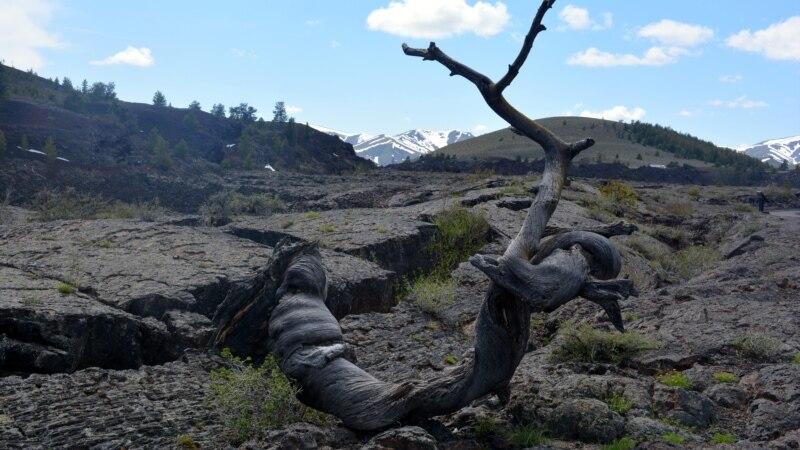'Walking on the Moon' in Idaho

Before America put the first men on the moon in 1969, NASA astronauts prepared for their lunar missions on the volcanic terrain at a national park.
Lunar landscape
National parks traveler Mikah Meyer says he now knows why those astronauts visited Craters of the Moon National Monument and Preserve in south-central Idaho.
“The area was the site of immense volcanic activity in the past,†he explained, so what’s left “is a kind of a ruins of volcanic rock…†-- which, with its vast ocean of lava flows and islands of cinder cones, resembles the surface of the moon.
Mikah got a great 360-degree view of the surreal landscape after hiking to the top of the Inferno Cone â€" a massive mound of cinder that rises out of the ground like a black mountain.
“It looks like a mountain but it's a cinder cone with this really loud, crunchy, sharp volcanic rock,†he said. “All throughout the park, whether it's the big Inferno Cone or smaller volcanoes, you’re basically walking around on this black volcanic lava that was once magma and is now hard rock.â€
Otherworldly encounters
Since much of the moon's surface is also covered by volcanic materials, in 1969, NASA sent astronauts Eugene Cernan, Joe Engle, Alan Shepard and Edgar Mitchell to Craters of the Moon to learn the basics of volcanic geology before their lunar missions.
Becoming familiar with the materials would help them when collecting samples of different rocks on the moon, and, since only a limited amount of material (385 kilos total in 6 moon landings) could be brought back, it was important that they know enough geology to pick up the most scientifically valuable specimens and be able to describe the surface features they were exploring to geologists back on Earth.
In 1999, astronauts Mitchell, Engle and Cernan returned to Craters of the Moon to help celebrate the site's 75th Anniversary, 30 years after training there. Alan Shepard had passed away in 1998.
A window into the past
Apollo 14 lunar module pilot Edgar Mitchell said their purpose and training “was to sample virtually all types of volcanic activity and the processes that go along with volcanism, because we had to be the eyes of the geological community on the moon and be able to accurately describe the various types of flows.â€
He noted that the surreal lunar landscape was also quite beautiful. “It has this peculiar, eerie beauty, like these flows do here, that are magnificent. I mean, they excite your imagination.â€
Shuttle astronaut Joe Engle noted that it wasn’t known before the Apollo missions what kind of rocks were on the lunar surface, “so Craters of the Moon was one of the really valuable places to come and look at and study lava flows.â€
Apollo 17 commander Eugene Cernan, the last man to walk on the moon, in December, 1972, described Craters of the Moon as “a spectacular place… an ideal place to study a high, broad range of the geologic impact.â€
"The volcanic activity that occurred on the moon is not dissimilar to the kind of thing we have seen here... the geology that's exposed here, it's just an open window into the past and this is what we were looking for in trying to learn something about geology... and this is the kind of place where we were able to do something like that."
Ancient rocks, new grass
Craters of the Moon formed during eight major eruptive periods between 15,000 and 2,000 years ago. Today its lava field covers 1600 square kilometers.
The site continues to be an important setting for space science research. In 2014, two research projects â€" FINESSE and BASALT â€" were launched at the park.
In the meantime, the lunar-like landscape continues to inspire visitors like Mikah. Looking out from the top of the Inferno Cone, he said, “You see the majestic contrast between the black dirt, the snow-capped mountains, and the older cinder cone which now have sagebrush and other grass and greens growing on them… it's quite the beautiful juxtaposition.â€
Mikah, who’s on a mission to visit all 417 units within the National Park Service, invites you to learn more about his travels across America by visiting him on his website, Facebook and Instagram.

0 Response to "'Walking on the Moon' in Idaho"
Posting Komentar